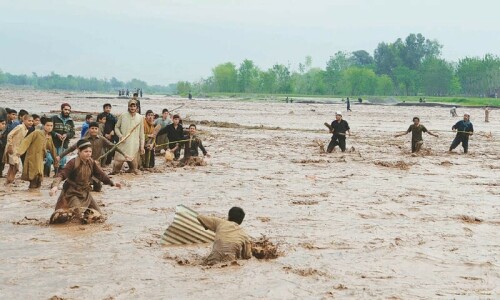IT is easy to be wise after the event. And one such wisdom has it that our blocking India’s commercial access to Iran and Afghanistan was bad strategy. We have lost out on benefits that would have come from improved commercial and political ties among the regional states.
Decades of shunning economic interaction with a large next door neighbour, while linking everything to the dispute over Kashmir was also bad policy. India’s economic growth rate in recent years has galloped and we found ourselves fenced out from an economy with which all other trading nations were lining up to do business with.
Similarly, trying to cultivate proxies in Afghanistan has not paid any dividends. That adventure has gone horribly wrong.
These inelegant strategies resulted from a strategy formulation process that, as one of its flaws, did not take economics into account.
The IPI gas pipeline was one initiative that would have given the regional countries a stake in the other’s peace and stability while easing the energy constraint to economic growth. However, while that could not progress as a result of exogenous factors beyond our control, the others are clearly a result of our own bad choices.
In any event, the net result has been regional isolation. In a world where countries now trade mostly within their regions, we barely have any economic interaction in ours except for the Afghan transit trade.
The gradual opening up with India is a breath of fresh air. It has the potential to become a growth driver for Pakistan’s economy.
Another key strategy piece to advance regional trade is the Gwadar port.
However, six years since its inauguration this port has still not earned its first million dollars. In fact Gwadar’s true calling is to become the region’s break-bulk hub. Presently, this business goes to ports and associated economic free zones in the United Arab Emirates. But Gwadar trumps these ports because its hinterland extends much deeper — into Central Asia. Why hasn’t the government been able to attract break bulk operators to Gwadar? A business plan to make this happen should be an utmost urgency.
Further down, on the same shoreline is Iran’s Chahbahar port. Blocked of overland access, India, Iran and Afghanistan reached a trilateral understanding in 2003 agreeing to develop a north-south corridor that would link Chahbabar with Afghanistan. India helped upgrade the port and in 2005, built the Afghanistan segment of the highway linking to the Afghanistan ring road. This meant that all major cities of Afghanistan could now connect with Chahbahar (in addition to Bandar Abbas).
The development fuelled Pakistan’s paranoia of ‘encirclement’. When construction crews working on the site came under relentless attacks from Taliban insurgents and a number of Indian engineers and Afghan workers were killed, the stakes went up. Shortly afterwards, Pakistan’s Baloch regions experienced unrest with insurgents specially targeting energy infrastructure. The mutual mistrust deepened and the antagonism widened to include Iran and Afghanistan as well.
In 2009 the highway — Route 606 as it is known — was inaugurated and today is open and busy during daytime though not totally safe, so vehicles have to travel in convoys and with armed escorts.
The 3000-km Afghanistan ring road itself is a giant carousel with exits that branch out to Iran (at Chahbahar and Herat), to Turkmenistan, Uzbekistan and Tajikistan and to Pakistan (taking you to the Khyber Pass, the next one to Miramshah and the third one to Quetta). The proposed Trans Afghanistan pipeline or Tapi is planned to transport gas and its 1200 km journey from Daulatabad to Quetta will follow the alignment along the ring road.
A common regional vision needs to be developed within a regional matrix. It needs to serve the interests of the people that inhabit this region. All the regional countries stand to reap a substantial peace dividend if they can lower mistrust and mutual suspicions.
This will immediately reduce the levels of conflict and we will see trade, traffic and energy flow across national borders. Major initiatives can include extending land access, opening borders, building logistic infrastructure, and entering currency swap and free trade agreements.
Pakistan can gain substantially by connecting the Gwadar port to the Afghanistan ring road and get the port operating at capacity. It would also stand to gain from allowing overland access to the regional countries. A virtuous spiral of peace, economic activity and prosperity can be created that will heal wounds that have been festering for decades. And in this Pakistan has the most to gain.
The writer is a business strategist and entrepreneur.










































